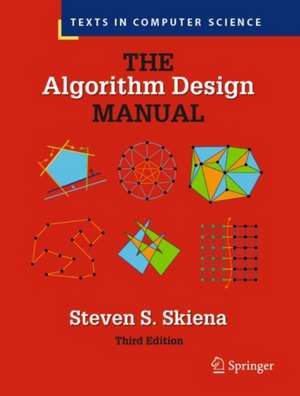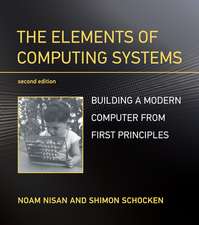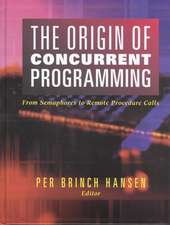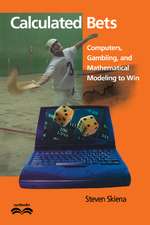The Algorithm Design Manual: Texts in Computer Science
Autor Steven S. Skienaen Limba Engleză Hardback – 6 oct 2020
"My absolute favorite for this kind of interview preparation is Steven Skiena’s The Algorithm Design Manual. More than any other book it helped me understand just how astonishingly commonplace … graph problems are -- they should be part of every working programmer’s toolkit. The book also covers basic data structures and sorting algorithms, which is a nice bonus. … every 1 – pager has a simple picture, making it easy to remember. This is a great way to learn how to identify hundreds of problem types." (Steve Yegge, Get that Job at Google)
"Steven Skiena’s Algorithm Design Manual retains its title as the best and most comprehensive practical algorithm guide to help identify and solve problems. … Every programmer should read this book, and anyone working in the field should keep it close to hand. … This is the best investment … a programmer or aspiring programmer can make." (Harold Thimbleby, Times Higher Education)
"It is wonderful to open to a random spot and discover an interesting algorithm. This is the only textbook I felt compelled to bring with me out of my student days.... The color really adds a lot of energy to the new edition of the book!" (Cory Bart, University of Delaware)
"The is the most approachable book on algorithms I have." (Megan Squire, Elon University)
---
This newly expanded and updated third edition of the best-selling classic continues to take the "mystery" out of designing algorithms, and analyzing their efficiency. It serves as the primary textbook of choice for algorithm design courses and interview self-study, while maintaining its status as the premier practical reference guide to algorithms for programmers, researchers, and students.
The reader-friendly Algorithm Design Manual provides straightforward access to combinatorial algorithms technology, stressing design over analysis. The first part, Practical Algorithm Design, provides accessible instruction on methods for designing and analyzing computer algorithms. The second part, the Hitchhiker's Guide to Algorithms, is intended for browsing and reference, and comprises the catalog of algorithmic resources, implementations, and an extensive bibliography.
NEW to the third edition:
-- New and expanded coverage of randomized algorithms, hashing, divide and conquer, approximation algorithms, and quantum computing
-- Provides full online support for lecturers, including an improved website component with lecture slides and videos
-- Full color illustrations and code instantly clarify difficult concepts
-- Includes several new "war stories" relating experiences from real-world applications
-- Over 100 new problems, including programming-challenge problems from LeetCode and Hackerrank.
-- Provides up-to-date links leading to the best implementations available in C, C++, and Java
Additional Learning Tools:
-- Contains a unique catalog identifying the 75 algorithmic problems that arise most often in practice, leading the reader down the right path to solve them
-- Exercises include "job interview problems" from major software companies
-- Highlighted "take home lessons" emphasize essential concepts
-- The "no theorem-proof" style provides a uniquely accessible and intuitive approach to a challenging subject
-- Many algorithms are presented with actual code (written in C)
-- Provides comprehensive references to both survey articles and the primary literature
Written by a well-known algorithms researcher who received the IEEE Computer Science and Engineering Teaching Award, this substantially enhanced third edition of The Algorithm Design Manual is an essential learning tool for students and professionals needed a solid grounding in algorithms. Professor Skiena is also the author of the popular Springer texts, The Data Science Design Manual and Programming Challenges: The Programming Contest Training Manual.
| Toate formatele și edițiile | Preț | Express |
|---|---|---|
| Paperback (1) | 379.63 lei 3-5 săpt. | +51.95 lei 7-13 zile |
| Springer International Publishing – 7 oct 2021 | 379.63 lei 3-5 săpt. | +51.95 lei 7-13 zile |
| Hardback (1) | 417.80 lei 3-5 săpt. | +59.23 lei 7-13 zile |
| Springer International Publishing – 6 oct 2020 | 417.80 lei 3-5 săpt. | +59.23 lei 7-13 zile |
Din seria Texts in Computer Science
- 17%
 Preț: 366.69 lei
Preț: 366.69 lei - 20%
 Preț: 675.35 lei
Preț: 675.35 lei - 20%
 Preț: 370.59 lei
Preț: 370.59 lei - 20%
 Preț: 411.75 lei
Preț: 411.75 lei - 20%
 Preț: 306.35 lei
Preț: 306.35 lei - 20%
 Preț: 474.58 lei
Preț: 474.58 lei - 20%
 Preț: 1244.39 lei
Preț: 1244.39 lei - 20%
 Preț: 409.70 lei
Preț: 409.70 lei - 20%
 Preț: 379.63 lei
Preț: 379.63 lei - 20%
 Preț: 444.93 lei
Preț: 444.93 lei - 20%
 Preț: 305.30 lei
Preț: 305.30 lei - 20%
 Preț: 406.21 lei
Preț: 406.21 lei - 20%
 Preț: 460.78 lei
Preț: 460.78 lei - 20%
 Preț: 503.87 lei
Preț: 503.87 lei - 20%
 Preț: 370.22 lei
Preț: 370.22 lei - 20%
 Preț: 411.53 lei
Preț: 411.53 lei - 20%
 Preț: 423.52 lei
Preț: 423.52 lei - 20%
 Preț: 441.70 lei
Preț: 441.70 lei - 20%
 Preț: 515.34 lei
Preț: 515.34 lei - 15%
 Preț: 637.58 lei
Preț: 637.58 lei - 20%
 Preț: 353.33 lei
Preț: 353.33 lei - 20%
 Preț: 356.82 lei
Preț: 356.82 lei - 20%
 Preț: 181.92 lei
Preț: 181.92 lei - 20%
 Preț: 330.42 lei
Preț: 330.42 lei - 20%
 Preț: 743.62 lei
Preț: 743.62 lei - 20%
 Preț: 663.45 lei
Preț: 663.45 lei -
 Preț: 457.75 lei
Preț: 457.75 lei - 20%
 Preț: 536.66 lei
Preț: 536.66 lei - 20%
 Preț: 358.24 lei
Preț: 358.24 lei -
 Preț: 385.84 lei
Preț: 385.84 lei - 20%
 Preț: 394.57 lei
Preț: 394.57 lei - 20%
 Preț: 344.76 lei
Preț: 344.76 lei - 20%
 Preț: 621.18 lei
Preț: 621.18 lei - 20%
 Preț: 350.86 lei
Preț: 350.86 lei - 20%
 Preț: 348.89 lei
Preț: 348.89 lei - 20%
 Preț: 339.95 lei
Preț: 339.95 lei - 20%
 Preț: 588.21 lei
Preț: 588.21 lei - 20%
 Preț: 199.57 lei
Preț: 199.57 lei - 20%
 Preț: 341.30 lei
Preț: 341.30 lei - 23%
 Preț: 726.93 lei
Preț: 726.93 lei - 20%
 Preț: 325.30 lei
Preț: 325.30 lei - 20%
 Preț: 595.80 lei
Preț: 595.80 lei - 20%
 Preț: 593.48 lei
Preț: 593.48 lei -
 Preț: 454.30 lei
Preț: 454.30 lei
Preț: 417.80 lei
Preț vechi: 522.24 lei
-20% Nou
79.94€ • 83.47$ • 66.17£
Carte disponibilă
Livrare economică 14-28 martie
Livrare express 28 februarie-06 martie pentru 69.22 lei
Specificații
ISBN-10: 3030542556
Pagini: 793
Ilustrații: XVII, 793 p. 1 illus.
Dimensiuni: 178 x 235 x 51 mm
Greutate: 1.47 kg
Ediția:3rd ed. 2020
Editura: Springer International Publishing
Colecția Springer
Seria Texts in Computer Science
Locul publicării:Cham, Switzerland
Cuprins
Introduction to Algorithm Design
Algorithm Analysis
Data Structures
Sorting and Searching
Divide and Conquer
Randomized Algorithms and Hashing
Graph Traversal
Weighted Graph Algorithms
Combinatorial Search and Heuristic Methods
Dynamic Programming
NP-Completeness
Dealing with Hard Problems
How to Design Algorithms
14 A Catalog of Algorithmic Problems 437
15 Data Structures 439
15.1 Dictionaries . . . . . . . . . . . . . . . . . . . . . . . . . . . . . . 440
15.2 Priority Queues . . . . . . . . . . . . . . . . . . . . . . . . . . . . 445
15.3 Sux Trees and Arrays . . . . . . . . . . . . . . . . . . . . . . . 448
15.4 Graph Data Structures . . . . . . . . . . . . . . . . . . . . . . . . 452
15.5 Set Data Structures . . . . . . . . . . . . . . . . . . . . . . . . . 456
15.6 Kd-Trees . . . . . . . . . . . . . . . . . . . . . . . . . . . . . . . 460
16 Numerical Problems 465
16.1 Solving Linear Equations . . . . . . . . . . . . . . . . . . . . . . 467
16.2 Bandwidth Reduction . . . . . . . . . . . . . . . . . . . . . . . . 470
16.3 Matrix Multiplication . . . . . . . . . . . . . . . . . . . . . . . . 472
16.4 Determinants and Permanents . . . . . . . . . . . . . . . . . . . 475
16.5 Constrained/Unconstrained Optimization . . . . . . . . . . . . . 478
16.6 Linear Programming . . . . . . . . . . . . . . . . . . . . . . . . . 482
16.7 Random Number Generation . . . . . . . . . . . . . . . . . . . . 486
16.8 Factoring and Primality Testing . . . . . . . . . . . . . . . . . . . 490
16.9 Arbitrary-Precision Arithmetic . . . . . . . . . . . . . . . . . . . 493
16.10Knapsack Problem . . . . . . . . . . . . . . . . . . . . . . . . . . 497
16.11Discrete Fourier Transform . . . . . . . . . . . . . . . . . . . . . 501
17 Combinatorial Problems 505
17.1 Sorting . . . . . . . . . . . . . . . . . . . . . . . . . . . . . . . . . 506
17.2 Searching . . . . . . . . . . . . . . . . . . . . . . . . . . . . . . . 510
17.3 Median and Selection . . . . . . . . . . . . . . . . . . . . . . . . . 514
17.4 Generating Permutations . . . . . . . . . . . . . . . . . . . . . . 517
17.5 Generating Subsets . . . . . . . . . . . . . . . . . . . . . . . . . . 521
17.6 Generating Partitions . . . . . . . . . . . . . . . . . . . . . . . . 524
17.7 Generating Graphs . . . . . . . . . . . . . . . . . . . . . . . . . . 528
17.8 Calendrical Calculations . . . . . . . . . . . . . . . . . . . . . . . 532
17.9 Job Scheduling . . . . . . . . . . . . . . . . . . . . . . . . . . . . 534
17.10Satisability . . . . . . . . . . . . . . . . . . . . . . . . . . . . . . 537
18 Graph Problems: Polynomial-Time 541
18.1 Connected Components . . . . . . . . . . . . . . . . . . . . . . . 542
18.2 Topological Sorting . . . . . . . . . . . . . . . . . . . . . . . . . . 546
18.3 Minimum Spanning Tree . . . . . . . . . . . . . . . . . . . . . . . 549
18.4 Shortest Path . . . . . . . . . . . . . . . . . . . . . . . . . . . . . 554
18.5 Transitive Closure and Reduction . . . . . . . . . . . . . . . . . . 559
18.6 Matching . . . . . . . . . . . . . . . . . . . . . . . . . . . . . . . 562
18.7 Eulerian Cycle/Chinese Postman . . . . . . . . . . . . . . . . . . 565
18.8 Edge and Vertex Connectivity . . . . . . . . . . . . . . . . . . . . 568
16 CONTENTS
18.9 Network Flow . . . . . . . . . . . . . . . . . . . . . . . . . . . . . 571
18.10Drawing Graphs Nicely . . . . . . . . . . . . . . . . . . . . . . . 574
18.11Drawing Trees . . . . . . . . . . . . . . . . . . . . . . . . . . . . 578
18.12Planarity Detection and Embedding . . . . . . . . . . . . . . . . 581
19 Graph Problems: NP-Hard 585
19.1 Clique . . . . . . . . . . . . . . . . . . . . . . . . . . . . . . . . . 586
19.2 Independent Set . . . . . . . . . . . . . . . . . . . . . . . . . . . 589
19.3 Vertex Cover . . . . . . . . . . . . . . . . . . . . . . . . . . . . . 591
19.4 Traveling Salesman Problem . . . . . . . . . . . . . . . . . . . . . 594
19.5 Hamiltonian Cycle . . . . . . . . . . . . . . . . . . . . . . . . . . 598
19.6 Graph Partition . . . . . . . . . . . . . . . . . . . . . . . . . . . . 601
19.7 Vertex Coloring . . . . . . . . . . . . . . . . . . . . . . . . . . . . 604
19.8 Edge Coloring . . . . . . . . . . . . . . . . . . . . . . . . . . . . . 608
19.9 Graph Isomorphism . . . . . . . . . . . . . . . . . . . . . . . . . 610
19.10Steiner Tree . . . . . . . . . . . . . . . . . . . . . . . . . . . . . . 614
19.11Feedback Edge/Vertex Set . . . . . . . . . . . . . . . . . . . . . . 618
20 Computational Geometry 621
20.1 Robust Geometric Primitives . . . . . . . . . . . . . . . . . . . . 622
20.2 Convex Hull . . . . . . . . . . . . . . . . . . . . . . . . . . . . . 626
20.3 Triangulation . . . . . . . . . . . . . . . . . . . . . . . . . . . . . 630
20.4 Voronoi Diagrams . . . . . . . . . . . . . . . . . . . . . . . . . . 634
20.5 Nearest Neighbor Search . . . . . . . . . . . . . . . . . . . . . . . 637
20.6 Range Search . . . . . . . . . . . . . . . . . . . . . . . . . . . . . 641
20.7 Point Location . . . . . . . . . . . . . . . . . . . . . . . . . . . . 644
20.8 Intersection Detection . . . . . . . . . . . . . . . . . . . . . . . . 648
20.9 Bin Packing . . . . . . . . . . . . . . . . . . . . . . . . . . . . . . 652
20.10Medial-Axis Transform . . . . . . . . . . . . . . . . . . . . . . . . 655
20.11Polygon Partitioning . . . . . . . . . . . . . . . . . . . . . . . . . 658
20.12Simplifying Polygons . . . . . . . . . . . . . . . . . . . . . . . . . 661
20.13Shape Similarity . . . . . . . . . . . . . . . . . . . . . . . . . . . 664
20.14Motion Planning . . . . . . . . . . . . . . . . . . . . . . . . . . . 667
20.15Maintaining Line Arrangements . . . . . . . . . . . . . . . . . . . 671
20.16Minkowski Sum . . . . . . . . . . . . . . . . . . . . . . . . . . . . 674
21 Set and String Problems 677
21.1 Set Cover . . . . . . . . . . . . . . . . . . . . . . . . . . . . . . . 678
21.2 Set Packing . . . . . . . . . . . . . . . . . . . . . . . . . . . . . . 682
21.3 String Matching . . . . . . . . . . . . . . . . . . . . . . . . . . . 685
21.4 Approximate String Matching . . . . . . . . . . . . . . . . . . . . 688
21.5 Text Compression . . . . . . . . . . . . . . . . . . . . . . . . . . 693
21.6 Cryptography . . . . . . . . . . . . . . . . . . . . . . . . . . . . . 697
21.7 Finite State Machine Minimization . . . . . . . . . . . . . . . . . 702
21.8 Longest Common Substring/Subsequence . . . . . . . . . . . . . 706
21.9 Shortest Common Superstring . . . . . . . . . . . . . . . . . . . . 709
CONTENTS 17
22 Algorithmic Resources 713
22.1 Algorithm Libraries . . . . . . . . . . . . . . . . . . . . . . . . . 713
22.1.1 LEDA . . . . . . . . . . . . . . . . . . . . . . . . . . . . . 713
22.1.2 CGAL . . . . . . . . . . . . . . . . . . . . . . . . . . . . . 714
22.1.3 Boost Graph Library . . . . . . . . . . . . . . . . . . . . . 714
22.1.4 Netlib . . . . . . . . . . . . . . . . . . . . . . . . . . . . . 714
22.1.5 Collected Algorithms of the ACM . . . . . . . . . . . . . 715
22.1.6 GitHub and SourceForge . . . . . . . . . . . . . . . . . . . 715
22.1.7 The Stanford GraphBase . . . . . . . . . . . . . . . . . . 715
22.1.8 Combinatorica . . . . . . . . . . . . . . . . . . . . . . . . 716
22.1.9 Programs from Books . . . . . . . . . . . . . . . . . . . . 716
22.2 Data Sources . . . . . . . . . . . . . . . . . . . . . . . . . . . . . 717
22.3 Online Bibliographic Resources . . . . . . . . . . . . . . . . . . . 718
22.4 Professional Consulting Services . . . . . . . . . . . . . . . . . . 718
23 Bibliography 719
Index 771
Notă biografică
Dr. Steven S. Skiena is Distinguished Teaching Professor of Computer Science at Stony Brook University, with research interests in data science, natural language processing, and algorithms. He was awarded the IEEE Computer Science and Engineering Undergraduate Teaching Award “for outstanding contributions to undergraduate education ...and for influential textbooks and software.”
Textul de pe ultima copertă
"My absolute favorite for this kind of interview preparation is Steven Skiena’s The Algorithm Design Manual. More than any other book it helped me understand just how astonishingly commonplace … graph problems are -- they should be part of every working programmer’s toolkit. The book also covers basic data structures and sorting algorithms, which is a nice bonus. … every 1 – pager has a simple picture, making it easy to remember." (Steve Yegge, Get that Job at Google)
"Steven Skiena’s Algorithm Design Manual retains its title as the best and most comprehensive practical algorithm guide to help identify and solve problems. … Every programmer should read this book, and anyone working in the field should keep it close to hand. … This is the best investment … a programmer or aspiring programmer can make." (Harold Thimbleby, Times Higher Education)
"It is wonderful to open to a random spot and discover an interesting algorithm. This is the only textbook I felt compelled to bring with me out of my student days.... The color really adds a lot of energy to the new edition of the book!" (Cory Bart, University of Delaware) ---
This newly expanded and updated third edition of the best-selling classic continues to take the "mystery" out of designing algorithms, and analyzing their efficiency. It serves as the primary textbook of choice for algorithm design courses and interview self-study, while maintaining its status as the premier practical reference guide to algorithms for programmers, researchers, and students.
The reader-friendly Algorithm Design Manual provides straightforward access to combinatorial algorithms technology, stressing design over analysis. The first part, Practical Algorithm Design, provides accessible instruction on methods for designing and analyzing computer algorithms. The second part, the Hitchhiker's Guide to Algorithms, is intended for browsing and reference, and comprises the catalog of algorithmic resources, implementations, and an extensive bibliography.
NEW to the third edition:
-- New and expanded coverage of randomized algorithms, hashing, divide and conquer, approximation algorithms, and quantum computing
-- Provides full online support for lecturers, including an improved website component with lecture slides and videos
-- Full color illustrations and code instantly clarify difficult concepts
-- Includes several new "war stories" relating experiences from real-world applications
-- Over 100 new problems, including programming-challenge problems from LeetCode and Hackerrank.
-- Provides up-to-date links leading to the best implementations available in C, C++, and Java
Additional Learning Tools:
-- Contains a unique catalog identifying the 75 algorithmic problems that arise most often in practice, and the right path to solve them
-- Exercises include "job interview problems" from major software companies
-- Highlighted "take home lessons" emphasize essential concepts
-- The "no theorem-proof" style provides a uniquely accessible and intuitive approach to a challenging subject
-- Many algorithms are presented with actual code (written in C)
-- Provides comprehensive references to both survey articles and the primary literature
This substantially enhanced third edition of The Algorithm Design Manual is an essential learning tool for students and professionals needed a solid grounding in algorithms. Professor Skiena is also the author of the popular Springer texts, The Data Science Design Manual and Programming Challenges: The Programming Contest Training Manual.
Caracteristici
This classic bestseller has been fully updated, and enhanced with new and expanded material on hashing and randomized algorithms, divide and conquer algorithms, and dealing with hard problems (including quantum algorithms)
Contains a highly unique catalog of the 75 most important algorithmic problems
Additional useful information such as lecture slides and updates available via author's website
Descriere
Most professional programmers that I’ve encountered are not well prepared to tacklealgorithmdesignproblems.Thisisapity,becausethetechniquesofalgorithm design form one of the core practical technologies of computer science. Designing correct, e?cient, and implementable algorithms for real-world problems requires access to two distinct bodies of knowledge: • Techniques – Good algorithm designers understand several fundamental - gorithm design techniques, including data structures, dynamic programming, depth-?rst search, backtracking, and heuristics. Perhaps the single most - portantdesigntechniqueismodeling,theartofabstractingamessyreal-world application into a clean problem suitable for algorithmic attack. • Resources – Good algorithm designers stand on the shoulders of giants. Ratherthanlaboringfromscratchtoproduceanewalgorithmforeverytask, they can ?gure out what is known about a particular problem. Rather than re-implementing popular algorithms from scratch, they seek existing imp- mentations to serve as a starting point. They are familiar with many classic algorithmic problems, which provide su?cient source material to model most any application. This book is intended as a manual on algorithm design, providing access to combinatorial algorithm technology for both students and computer professionals.




















